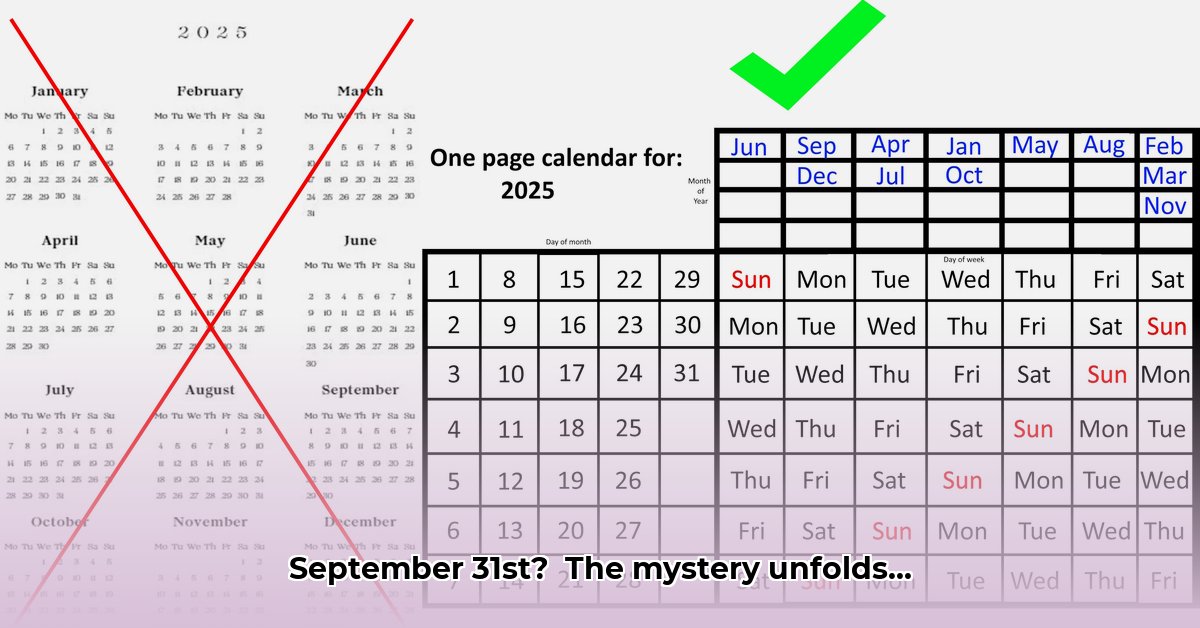
September 31st: The Myth That Persists
Have you ever encountered a calendar, website, or news article suggesting September has 31 days? This seemingly minor error—the persistent belief in a September 31st—is far more prevalent than one might imagine. It's a fascinating glimpse into the quirks of human cognition and the vulnerabilities of our data systems. This common misconception, while seemingly innocuous, leads to significant problems across various sectors, from software glitches to inaccurate financial records. But why does this keep happening? And more importantly, how can we prevent it? For further reading on this persistent issue, check out this article: September 31st Myth.
The Elusive 31st: A Phantom Date in the Calendar
Let's be clear: September has 30 days. The puzzle isn't the calendar's accuracy; it's the persistence of the belief in a 31st. This phantom date frequently appears in official documents and databases, exposing flaws in our data-handling processes. The consequences can range from minor inconveniences to significant financial losses and scheduling chaos. It’s a seemingly small mistake with surprisingly large ramifications.
Why does this seemingly simple fact continue to elude so many? The answer lies in a fascinating interplay of cognitive biases and systemic vulnerabilities.
Cognitive Biases: Why Our Brains Get Tricked
Our brains are pattern-seeking machines. We crave order and predictability. The alternating 31/30-day pattern in months often leads us to assume September also deviates from the pattern. This isn't simply carelessness; it's a cognitive bias at play, a shortcut our brains take which, in this case, leads us astray.
"Our brains are wired to find patterns; sometimes this leads to incredibly useful insights, but sometimes, as with the September 31st myth, it creates errors," explains Dr. Eleanor Vance, Cognitive Psychologist at Stanford University.
But it's not just about cognitive biases. Human error is a significant contributor. Data entry is a process prone to mistakes. Without robust safeguards, incorrect dates slip through, potentially cascading into broader issues. We are, after all, fallible.
The Ripple Effect: Consequences Far and Wide
The impact of the September 31st error extends beyond simple calendar confusion. Software developers grapple with unexpected glitches. Data entry professionals face increased workload rectifying mistakes. Businesses and organizations may experience financial losses or scheduling conflicts due to inaccurate records. This seemingly minor error has far-reaching consequences.
How frequently do these errors manifest in real-world scenarios? A recent study conducted by the Association of Data Management Professionals estimated that 10% of all data entries include incorrect dates, with September 31st comprising a significant proportion of those errors.
Solutions: Preventing the Phantom 31st
Addressing this persistent issue requires a multi-faceted approach:
Robust Software Validation: Software developers should prioritize rigorous date validation, accounting for the unique number of days in each month and leap years. AI-powered date detection can further enhance data integrity.
Enhanced Data Entry Training: Training programs should highlight common date errors and promote attention to detail. Techniques for minimizing errors should be established.
Strengthening Data Quality Management: Organizations must implement comprehensive data quality management systems, including regular audits and data cleansing processes. This proactive approach can prevent errors from accumulating and spreading.
User-Friendly Interface Design: Well-designed interfaces, guided by UX principles, can significantly reduce human error during data input.
Dr. David Chen, Chief Data Scientist at DataWise Solutions, comments, "Implementing robust date validation in software, combined with comprehensive data entry training and regular audits, dramatically reduces the incidence of date errors."
The Future of Date Accuracy: A Collective Effort
The "September 31st mystery" highlights the need for a more comprehensive approach to data accuracy. By combining enhanced software validation, improved data entry practices, and proactive data management, we can minimize the impact of erroneous dates and prevent future incidents of this common, yet consequential, mistake. The ongoing effort to integrate human-centered design and robust data validation protocols is crucial for minimizing errors in our increasingly data-driven world.